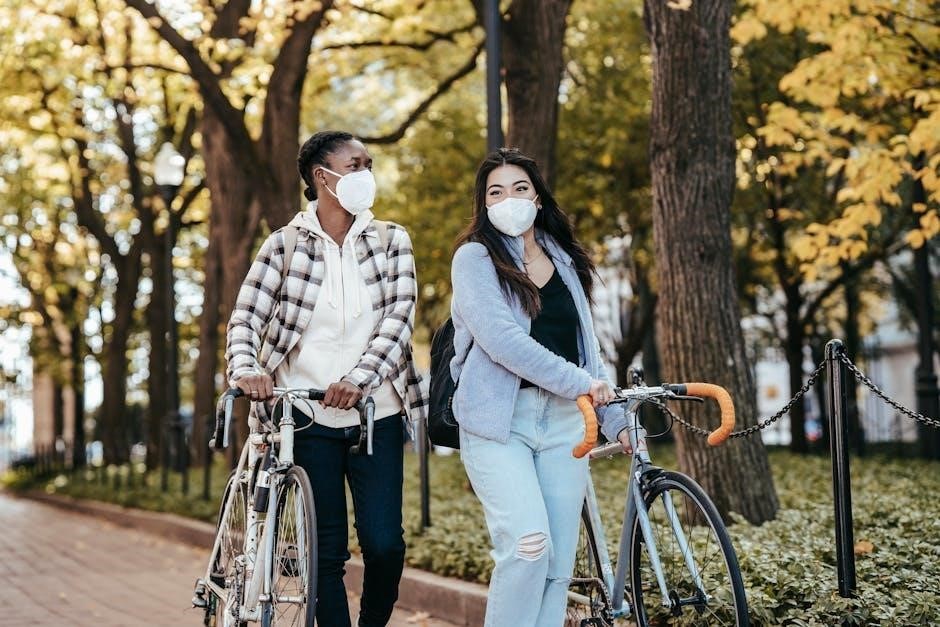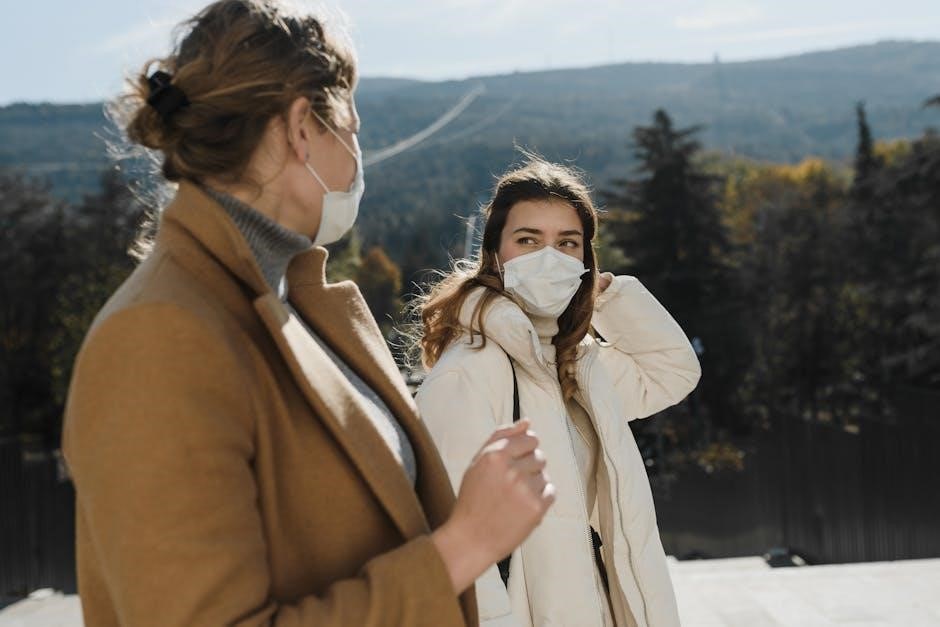A toolbox talk is a short, informal discussion focused on workplace safety topics like fall protection. It educates workers on hazards, prevention, and compliance with safety standards.
What is a Toolbox Talk?
A toolbox talk is a short, informal safety discussion focused on specific workplace hazards, such as fall protection. It provides workers with practical knowledge on preventing accidents, understanding risks, and using safety equipment effectively. These talks are usually conducted on-site, involving all team members to ensure everyone is informed and aligned on safety practices. They often cover topics like common causes of falls, best practices for equipment use, and regulatory requirements. A toolbox talk is an essential tool for promoting a safety-first culture and ensuring compliance with standards like OSHA. Employers can use PDF guides to structure these discussions and keep workers engaged. Regular toolbox talks help prevent incidents and save lives.
Why Fall Protection is Critical in Workplace Safety
Fall protection is essential to prevent injuries and fatalities in workplaces, especially in high-risk environments like construction sites. Falls are a leading cause of workplace accidents, often resulting in severe injuries or death. OSHA requires employers to provide fall protection systems, such as safety nets or personal fall arrest equipment, to safeguard workers at heights. These measures not only protect employees but also help companies avoid legal penalties and financial losses. Proper fall protection ensures compliance with safety standards, reduces incidents, and fosters a safer work environment. Employers must prioritize fall protection to save lives and maintain a productive, incident-free workplace.

Understanding Fall Hazards
Fall hazards, such as slippery surfaces, unstable structures, and improper scaffolding, pose significant risks to workers. Identifying these dangers is crucial for preventing accidents and ensuring safety.
Common Causes of Falls in the Workplace
Common causes of workplace falls include slippery or uneven surfaces, poor lighting, cluttered walkways, and unstable structures. Human factors like fatigue, haste, or lack of training also contribute. Equipment failure, improper ladder use, and inadequate guardrails can exacerbate risks. Weather conditions, such as rain or ice, further increase hazards. Additionally, poor housekeeping and obstructed pathways often lead to tripping incidents. Employers must address these factors through regular inspections, proper maintenance, and comprehensive safety training to minimize fall risks and protect workers effectively.
Identifying Fall Hazards on Construction Sites
Construction sites pose unique fall hazards due to elevated work areas, unstable structures, and dynamic environments. Common hazards include unprotected edges, open-sided floors, and scaffolding without proper guardrails. Ladders, rooftops, and equipment like cranes or forklifts also increase fall risks. Additionally, uneven or unstable surfaces, such as loose decking or temporary platforms, can lead to slips or trips. Changing site layouts and weather conditions like rain or ice further complicate safety. Regular inspections, proper signage, and employee training are essential to identify and mitigate these hazards, ensuring a safer working environment for all construction workers.
Regulatory Requirements for Fall Protection
Regulations mandate employers to implement fall protection measures, conduct risk assessments, and ensure compliance with OSHA and ANSI standards, providing proper equipment and training to prevent falls.
OSHA Standards for Fall Protection
OSHA standards, specifically 29 CFR 1926.501, require employers to provide fall protection for employees working at heights of 6 feet or more. These standards mandate guardrails, safety nets, or personal fall arrest systems (PFAS) in construction settings. Employers must assess job sites to identify fall hazards and implement controls. Training is essential, with OSHA requiring workers to understand fall risks and equipment use. Regular inspections of fall protection equipment are also mandated to ensure compliance and safety. Employers must document training and inspections, maintaining records for compliance. Adhering to OSHA standards helps prevent falls, the leading cause of construction fatalities, ensuring a safer workplace.
Compliance and Legal Obligations
Compliance with fall protection regulations is not just a safety measure but a legal requirement. Employers must adhere to OSHA standards and other applicable laws to avoid penalties and legal liabilities. Failure to provide proper fall protection measures can result in fines, legal action, and reputational damage. Companies must ensure all fall protection practices align with current regulations, including proper equipment, training, and documentation. Legal obligations extend to protecting workers’ rights to a safe work environment. Non-compliance can lead to severe consequences, emphasizing the importance of proactive adherence to safety laws. Employers must stay updated on regulatory changes to maintain compliance and safeguard their workforce effectively.

Components of a Fall Protection Program
A comprehensive program includes hazard ID, risk assessment, equipment selection, training, and inspections to ensure a safe working environment and prevent falls effectively.
- Hazard identification
- Equipment selection
- Training
- Inspections
Hazard Identification and Risk Assessment
Hazard identification and risk assessment are critical components of a fall protection program. These steps involve recognizing potential fall hazards, evaluating their severity, and determining the likelihood of incidents. Employers must systematically inspect workplaces to identify unsafe conditions, such as unprotected edges, unstable surfaces, or equipment misuse. Risk assessment prioritizes hazards based on factors like height, surface type, and task complexity. This process ensures that proactive measures, like guardrails or safety nets, are implemented to mitigate risks. Regular updates to hazard assessments are essential as work conditions change. By addressing hazards early, employers can significantly reduce fall-related incidents and ensure a safer work environment for everyone.

- Identify potential fall hazards
- Evaluate risk levels
- Implement controls
- Monitor and update assessments
Proactive hazard management is key to preventing falls and ensuring compliance with safety standards.
Equipment Selection and Maintenance
Proper equipment selection and maintenance are vital for ensuring fall protection systems function effectively. Employers must choose equipment that matches the identified hazards and complies with industry standards. Full-body harnesses, lanyards, and anchorage points should be selected based on specific tasks and environments. Regular inspections are essential to detect wear, damage, or degradation. Maintenance schedules must follow manufacturer guidelines, and defective equipment should be immediately removed from service. Training employees on equipment care and inspection ensures longevity and reliability. Proper storage and documentation of maintenance activities are also critical for compliance and accountability.
- Select equipment based on hazard assessments
- Inspect equipment regularly
- Follow manufacturer maintenance guidelines
- Document inspection and maintenance records
Well-maintained equipment is essential for preventing falls and safeguarding workers.
Training and Competency Development
Effective fall protection training is essential for ensuring workers understand and apply safety measures correctly. Employers must provide comprehensive training programs that cover hazard recognition, equipment use, and emergency procedures. Training should include both theoretical knowledge and practical demonstrations to ensure competency. Regular refresher courses are necessary to reinforce learning and adapt to new regulations or equipment. Supervisors should assess workers’ understanding and skills to confirm readiness for tasks involving fall risks. Proper training not only reduces incidents but also fosters a culture of safety and accountability in the workplace.
- Include hands-on exercises
- Provide regular refreshers
- Document training completion
Competent workers are better equipped to prevent falls and protect themselves.

Types of Fall Protection Systems
Fall protection systems include guardrails, safety nets, fall arrest systems, and personal fall protection equipment (PFPE). Each system is designed to prevent or arrest falls effectively.
- Guardrails
- Safety nets
- PFPE
Choosing the right system ensures workplace safety and compliance with regulations.
Guardrails and Barriers
Guardrails and barriers are essential components of fall protection systems, providing a physical barrier to prevent workers from falling. They are commonly installed along rooftops, scaffolding, and walkways. These systems are passive, requiring no action from workers to ensure protection. Guardrails typically consist of a horizontal rail supported by posts, while barriers are solid structures designed to block access to hazardous areas. Both must meet specific standards, such as OSHA regulations, to ensure effectiveness. Proper installation, inspection, and maintenance are critical to their functionality. Guardrails and barriers are cost-effective and provide a reliable layer of safety, making them a fundamental part of workplace fall prevention strategies.
Safety Nets and Fall Arrest Systems
Safety nets and fall arrest systems are critical fall protection measures, especially in high-risk environments. Safety nets are installed below work areas to catch falling workers, minimizing injury risk. Fall arrest systems, including harnesses, lanyards, and anchors, stop falls and distribute force to prevent harm. These systems are often used in construction, bridge work, and other elevated tasks where guardrails aren’t feasible. Proper setup and adherence to OSHA standards are essential for reliability. Regular inspections ensure equipment functionality, preventing failures. These systems provide a last line of defense, protecting workers from severe injuries or fatalities, and are vital in industries with significant fall hazards.
Personal Fall Protection Equipment (PFPE)
Personal Fall Protection Equipment (PFPE) is essential for safeguarding workers at heights. It includes full-body harnesses, lanyards, energy absorbers, and connectors. Harnesses distribute force across the body during a fall, while lanyards connect the worker to an anchor point. Energy absorbers reduce the impact force, ensuring a controlled arrest. Connectors, such as snap hooks, secure the system to stable structures. PFPE must fit properly and be used as part of a comprehensive fall protection plan. Regular inspection and adherence to ANSI and OSHA standards are critical to ensure reliability. Proper training on equipment use, maintenance, and limitations is vital for worker safety and compliance with safety protocols.
Personal Protective Equipment (PPE) for Fall Protection
Personal Protective Equipment (PPE) for fall protection includes harnesses, hard hats, and safety glasses. It safeguards workers from fall-related injuries and ensures compliance with safety regulations.
Full-Body Harnesses
A full-body harness is a critical component of fall protection, distributing force across the body during a fall. It features straps and buckles that secure the torso, legs, and shoulders, preventing injury. Proper fitting and adjustment are essential to ensure safety and comfort. Harnesses are made from durable materials like nylon or polyester, designed to withstand heavy use. Regular inspection is required to identify wear, tears, or damage. Employers must ensure harnesses meet safety standards, such as those set by ANSI or OSHA. Training on proper use and maintenance is vital to maximize protection and minimize risks in high-hazard environments.
Lanyards and Energy Absorbers
Lanyards and energy absorbers are essential components of fall protection systems, connecting the harness to an anchor point. Lanyards act as a flexible link, while energy absorbers reduce the force of a fall by dissipating energy. They are designed to limit the impact on the worker’s body during a fall. Proper use and inspection are critical to ensure effectiveness. Lanyards must be adjusted to the correct length to prevent excessive free fall. Energy absorbers should be inspected for damage or wear before each use. Always follow manufacturer guidelines for maintenance and replacement to ensure optimal performance and compliance with safety standards; Regular training is key to understanding their proper use and limitations in workplace safety.
Connectors and Anchorage Points
Connectors and anchorage points are critical components of fall protection systems, ensuring a secure link between the worker and a stable structure. Connectors, such as karabiners or snap hooks, must be compatible with the anchorage and rated for the intended load. Anchorage points must be structurally sound, capable of withstanding a minimum of 5,000 pounds of force per worker. Proper selection and installation are essential to prevent system failure. Regular inspection of connectors and anchorage points is required to ensure they remain safe and functional. Always follow manufacturer guidelines and consult engineering surveys to identify suitable anchorage locations, avoiding unstable or damaged structures. Compliance with industry standards ensures worker safety and system reliability. Proper training and inspection are vital to maintaining the integrity of these components. Regular maintenance and replacement of worn or damaged connectors and anchorage points are necessary to uphold safety standards. Always ensure connectors are securely attached to prevent accidental disengagement. An anchorage point should never be overloaded or used beyond its rated capacity. Engineering surveys can help identify safe anchorage points in complex work environments. Avoid using makeshift or unstable objects as anchorage points, as they can lead to system failure. Proper training on the use and inspection of connectors and anchorage points is essential for worker safety. Regular audits should be conducted to ensure compliance with safety standards and regulations. By prioritizing the integrity of connectors and anchorage points, employers can significantly reduce the risk of falls in the workplace. Proper installation, inspection, and maintenance of these components are key to ensuring a reliable fall protection system. Always adhere to manufacturer guidelines and industry best practices when selecting and using connectors and anchorage points.
Safe Work Practices

Ensuring adherence to safety protocols, proper equipment use, and hazard assessment are vital. Always follow guidelines, maintain situational awareness, and plan tasks carefully to minimize risks without compromising safety standards.
Proper Use of Fall Protection Equipment
Using fall protection equipment correctly is essential for ensuring safety. Always inspect gear before use, follow manufacturer guidelines, and ensure proper fit. Harnesses, lanyards, and anchor points must be securely connected. Never modify equipment or bypass safety features. Employees should be trained on the correct procedures for donning and doffing PPE. Double-check connections and systems before starting work at heights. Regular inspection routines help identify wear or damage. Proper use prevents equipment failure and ensures compliance with safety standards. Training programs should emphasize hands-on practice to reinforce correct techniques. Always prioritize situational awareness to adapt equipment use to specific work conditions.
Inspection and Maintenance of Equipment
Regular inspection and maintenance of fall protection equipment are crucial for ensuring reliability and safety. Conduct daily pre-use checks for damage, wear, or deterioration. Look for frays, cuts, or excessive abrasion in ropes and webbing, and ensure all hardware is free from corrosion or deformation. Detailed inspections should be performed by a competent person at least annually or as per manufacturer guidelines. Maintain records of inspections and maintenance. Damaged or unsafe equipment must be immediately removed from service and repaired or replaced. Follow manufacturer instructions for cleaning, storage, and lubrication to extend equipment lifespan. Proper maintenance prevents equipment failure, reducing fall risks and ensuring compliance with safety regulations.
Emergency Response and Rescue Plans
Developing robust emergency response and rescue plans is essential for minimizing risks after a fall occurs. Ensure all workers are trained in rescue techniques and understand their roles during an emergency. Equip the site with first aid kits, communication devices, and rescue gear compatible with fall protection systems. Establish clear procedures for stabilizing fallen workers, preventing further injuries, and promptly summoning medical assistance. Regularly conduct drills to test the effectiveness of the plan and identify areas for improvement. Maintain documentation of rescue training, drills, and incident responses to refine strategies continuously. A well-prepared rescue plan ensures timely and effective action, critical for saving lives and reducing severe outcomes in fall incidents.

Conducting Effective Toolbox Talks
Plan engaging discussions, encourage participation, and emphasize clear safety practices. Use visual aids and real-life examples to reinforce fall protection principles and promote a culture of safety.

How to Engage Workers in Safety Discussions
To effectively engage workers, create a safe and inclusive environment where everyone feels comfortable participating. Start by asking open-ended questions to encourage interaction and share real-life examples to illustrate key points. Use relatable scenarios or case studies to make discussions practical and relevant. Encourage workers to share their experiences or concerns about fall hazards and actively listen to their feedback. Recognize and acknowledge contributions to foster a sense of ownership and motivation. End the discussion by summarizing key takeaways and reinforcing the importance of fall protection in their daily tasks. This approach builds trust and promotes a proactive safety culture.
Key Topics to Cover in a Fall Protection Toolbox Talk
A fall protection toolbox talk should cover essential topics to ensure workers are well-informed and prepared. Start with hazard identification, discussing common fall risks like uneven surfaces, heights, and equipment misuse. Emphasize proper equipment usage, including harnesses, lanyards, and anchorage points. Review regulatory requirements and company policies to ensure compliance. Include safe work practices, such as maintaining three points of contact and avoiding unsafe shortcuts. Discuss emergency response plans, like rescue procedures after a fall. Use real-life examples to illustrate risks and solutions. Finally, address worker responsibilities, such as reporting hazards and inspecting equipment. Keep discussions clear, concise, and relevant to daily tasks.
Encouraging Participation and Q&A

Encouraging participation and fostering an open Q&A session is crucial for effective toolbox talks. Create a safe, non-intimidating environment where workers feel comfortable sharing concerns and asking questions. Recognize and acknowledge contributors to motivate others to engage. Pose open-ended questions to stimulate discussion and ensure clarity on key topics. Address each inquiry thoughtfully, providing clear, accurate answers. If unsure about a response, commit to finding the correct information later. Encourage workers to share personal experiences or near-miss incidents to highlight lessons learned. This collaborative approach not only boosts engagement but also strengthens the team’s collective understanding of fall protection practices and safety protocols.
Case Studies and Real-Life Examples

Real-life examples highlight successful fall protection implementations and past incidents, offering practical lessons and reinforcing the importance of proper safety protocols in workplace environments.
Learning from Past Incidents
Analyzing past fall incidents provides valuable insights into common hazards and preventive measures. Many workplace falls result from equipment failure, improper training, or unsafe practices. For example, a construction worker fell from a scaffold due to missing guardrails, highlighting the importance of proper setup and inspection. Another incident involved a ladder slipping on an uneven surface, emphasizing the need for secure positioning. These cases underscore the critical role of hazard identification, equipment maintenance, and adherence to safety protocols. By studying such incidents, employers can improve safety standards, reduce risks, and ensure compliance with regulations, ultimately preventing future accidents and safeguarding workers.
Success Stories in Fall Protection
Several companies have achieved remarkable success in fall protection by implementing robust safety measures. For instance, a leading construction firm reduced fall-related incidents by 90% after adopting advanced safety nets and rigorous training programs. Another manufacturing plant eliminated falls entirely by installing guardrails and enforcing strict PPE policies. These success stories highlight the effectiveness of proactive approaches, such as regular equipment inspections, employee training, and hazard assessments. By prioritizing fall protection, organizations not only protect their workers but also enhance productivity and reputation. These examples serve as inspiration for others to adopt similar strategies and achieve zero-fall workplaces through commitment and innovation.
Key Takeaways from the Toolbox Talk
The key takeaways emphasize the importance of fall protection in preventing injuries and fatalities. Employers must ensure compliance with safety regulations, conduct regular hazard assessments, and provide proper training. Workers should always inspect equipment, use personal protective gear correctly, and report unsafe conditions. Establishing clear emergency response plans and fostering a safety-first culture are essential. Continuous improvement through feedback and updates on new safety measures will help maintain a safe working environment. Ultimately, prioritizing fall protection saves lives and ensures a secure workplace for everyone.
Implementing Fall Protection Strategies
Implementing fall protection strategies requires a proactive approach to workplace safety. Start by developing a comprehensive fall protection plan tailored to your workplace hazards. Conduct regular inspections of equipment and work areas to ensure compliance. Train employees on proper techniques, equipment use, and emergency procedures. Encourage a culture of safety by promoting open communication and accountability. Establish clear protocols for addressing hazards and incidents. Regularly review and update safety practices to adapt to changing conditions. By taking these steps, organizations can create a safer environment, reduce risks, and ensure compliance with safety regulations. Continuous improvement is key to long-term success.
